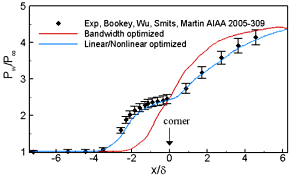Flow Simulation: Numerical methods for resolved simulations of compressible turbulence
 |
|
Wall-pressure distribution for STBLI |
We work on the development of techniques that enable fully resolved numerical simulations of turbulence that do not require a turbulence model, known as direct numerical simulations (DNS). Existing numerical methods were unable to distinguish shockwaves in a general and robust way, important for application to compressible flow problems. To address this problem, Dr. Martin and her students began using a class of non-linear numerical methods for robust shock capturing in laminar flows, weighted essentially non-oscillatory (WENO) methods, which were known to be overly dissipative for turbulence. We have investigated the sources of numerical dissipation and introduced the distinction between linear and non-linear numerical dissipation for WENO methods.
This work on refashioning a class of numerical methods for the simulation of highly compressible turbulence has allowed us to examine the details of hypersonic flow at small and large scales, revealing features ranging in length from micrometers to meters and occurring at frequencies from kHz to MHz. With this ability, the simulations recognize the distinction between smooth fluctuations and shockwaves, making them extremely powerful tools for investigating a broad range of physical phenomena existing in highly compressible turbulence for the first time. Our simulations have provided numerical data that are impossible to obtain with other existing methods or from experiments of high-speed flows. In addition, we have developed a new implicit time integration technique that results in time-saving factors of about six relative to explicit time integration methods.
